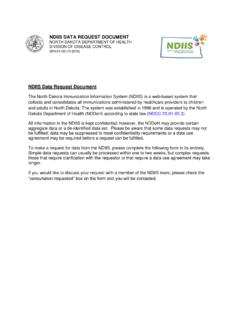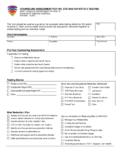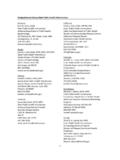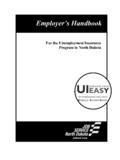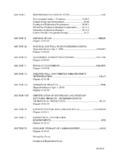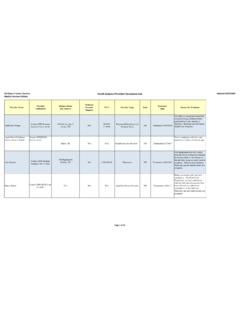Transcription of INFLUENZA2017-18 Weekly Report - ndflu.com
1 North Dakota Weekly Influenza Update 2017-18 Influenza Season Through week 201820, the week ending 5/19/2018 Edited by: Jill K Baber, MPH. All data are preliminary and based on reports received at the time of publication. Published 5/24/2018. As of week 20: This season (2017-18) Last season (2016-17). Cases reported for week 25 14. Cumulative cases for season 8,498 7,485. Activity level Sporadic Sporadic Influenza activity has continued to decline. Sporadic cases do continue to pop up across the state, so residents should continue to protect themselves through vaccination, handwashing, and staying away from people who are sick. A variety of other respiratory diseases are circulating right now, including human metapneumovirus and rhinovirus. If you are sick, be sure to cover your coughs and sneezes and stay home to avoid spreading your illness to other people. This will be the last regular Weekly Report for the 2017-18 influenza season. Supplementary reports will be published this summer if any unusual activity occurs.
2 Remember that influenza circulates in low numbers year-round. A special THANK YOU to our sentinel providers for their time and effort in contributing to influenza surveillance in North Dakota! Weekly reports will resume in October for the 2018-19 season. Number of Reported Laboratory-Identified Influenza Cases by Type Influenza Cases by Week Number 1000 A, unspecified 5,896. 900 2009 A H1N1 52. 800 A H3 536. 700 B, unspecified 1,852. 600 B Yamagata 142. 500 B Victoria 20. 400. All laboatory-idenfied cases of 300. influenza (including identification 200. via rapid test) are reportable in 100 North Dakota. Statistics do not 0 include data from people who did 201731. 201733. 201735. 201737. 201739. 201741. 201743. 201745. 201747. 201749. 201751. 201801. 201803. 201805. 201807. 201809. 201811. 201813. 201815. 201817. 201819. 201821. 201823. 201825. 201827. 201829. not seek medical care for their illness, or who sought medical care but were diagnosesd based on AH3 2009AH1 InfA InfB InfBYam InfBVic symptoms, not with a laboratory test.
3 1. Demographic Data Case Count for Lab-Confirmed Cases by Age Group Case Count for Lab- Confirmed Cases by Gender 2192 1240 911 943 705 717 1790. 4457 4041. 0% 20% 40% 60% 80% 100%. Percent of All Cases MALE FEMALE. <10 10-19 20-29 30-39 40-49 50-59 60+. Lab-Confirmed Cases by County 2. Deaths, Hospitalizations, and Outbreaks Deaths The NDDoH obtains death information from state Vital Number of Deaths Records data. For surveillance, both influenza and pneumonia death for 2017-18. information is collected. Although a variety of pathogens can cause Pneumonia 438. severe pneumonia, we know that when influenza is circulating, Influenza 31. influenza contributes considerably to the number of pneumonia deaths, even when influenza is not diagnosed or coded on the death certificate. Number of Pneumonia and Influenza Deaths by Week Number 25. 20. 15. 10. 5. 0. Hospitalizations There have been 306 influenza-related hospitalizations reported for the 2017- 18 season. Hospitalization status for influenza cases is not required to be reported.
4 This information is also not received with electronic laboratory reports, greatly decreasing the number of hospitalizations reported to the NDDoH. We are currently exploring more reliable ways to receive this data. Outbreaks Influenza or influenza-like illness outbreaks in institutional settings (schools, long term & basic care facilities, prisons, etc.) and in the general community are common during the influenza season. Institutional outbreaks are mandatorily reportable to the NDDoH. There have been 38 reported outbreaks of influenza-like illness in long term, assisted, basic care, or group home settings; 24 caused by Influenza A (not subtyped), one caused by influenza A. H3N2, four caused by unknown influenza type, one caused by both influenza A and B, one caused by both Influenza A and RSV, and seven caused by influenza B. The NDDoH has also received reports of seven influenza A outbreaks in schools, and four influenza A outbreaks in child care settings. 3.
5 Multi-Season Comparison Total Peak Week Predominant A variety of changes over the past Season Cases (week ending) Strain few years has made comparing 2013-14 2,923 1/4/2014 2009 A H1N1 influenza case data over time more 2014-15 6,443 12/27/2014 A H3N2 difficult. Widespread use electronic 2015-16 1,942 3/12/2016 2009 A H1N1 laboratory reporting in recent years 2016-17 7,507 2/18/2017 A H3N2 has greatly reduced underreporting 2017-18 8,498 1/27/2018 A H3N2 and increased our case counts. This is likely why the 2016-17 season, a fairly moderate season, saw our highest seasonal case counts on record. Starting this season, however, many of our providers and facilities, including those of our largest health system, are currently transitioning to new influenza testing protocol that affects who is tested and when testing occurs. The result will be fewer people tested, but higher data reliability. Changes in how data are collected over time are inevitable. These changes are not bad, but need to be considered when reviewing data over time.
6 At the moment, changes may be suppressing the true magnitude of the season when compared with previous seasons. North Dakota Influenza Cases by Week, 2013-Current Season 1000. 900. 800. 700. 600. 500. 400. 300. 200. 100. 0. Week Number 2013-14 Season 2014-15 Season 2015-16 Season 2016-17 Season 2017-18 Season 4. Sentinel Surveillance: Outpatient Influenza-like Illness The North Dakota Department of Health (NDDoH) participates with other states and jurisdictions in the Outpatient Influenza-like Illness Surveillance Network (ILINET). Data from this project is used in the CDC's Weekly FluView Report . Participating outpatient clinics send data on the number of patients in each of five age groups experiencing ILI, and the number of patients seen for any reason each week. ILI is defined as: Fever of 100 F or greater with A cough AND/OR sore throat Data for all providers is pooled, and a state-wide statistic for percent of visits for ILI is produced. In North Dakota, a percent ILI of or greater is considered season-level activity.
7 Current Activity This week, ILI is We are below the seasonal baseline. Week 2017-18 # ILI 0-4 # ILI 5-24 # ILI 25-49 # ILI 50-64 # ILI 65+ Total #. Number Percent ILI age group age group age group age group age group visits 201817 0 4 3 2 1 1415. 201818 0 0 0 0 0 1305. 201819 1 2 1 0 0 1018. 201820 0 1 1 0 0 1038. Percent of Outpatient Visits Due to Influenza-like Illness by Week, Current and Previous Season 8. 7. 6. 5. 4. 3. 2. 1. 0. 201731. 201732. 201733. 201734. 201735. 201736. 201737. 201738. 201739. 201740. 201741. 201742. 201743. 201744. 201745. 201746. 201747. 201748. 201749. 201750. 201751. 201752. 201801. 201802. 201803. 201804. 201805. 201806. 201807. 201808. 201809. 201810. 201811. 201812. 201813. 201814. 201815. 201816. 201817. 201818. 201819. 201820. Week Number 2017-18 2016-17 Seasonal Baseline 5. Sentinel Surveillance: Laboratory Data Laboratory Surveillance: Influenza The NDDoH receives influenza testing data from participating sentinel laboratories across North Dakota.
8 The total number of influenza tests (all testing methodologies) and the total number of those tests that are positive are reported each week. Data for all labs is pooled, and a state-wide percent positivity statistic is produced. Percent positivity for influenza testing of 10% is greater is considered a general indicator for season-level influenza activity. This week, percent positivity for influenza is Percent Positivity of Influenza Testing and the Total Number of Tests Conducted Percent of Tests Positive for Total Number of Tests 2500 35. 2000 30. Conducted 25. 1500. Influenza 20. 1000 15. 10. 500 5. 0 0. Week Number Number of Influenza Tests Conducted Percent Positivity for Influenza Tests Seasonal Baseline for Percent Positivity Laboratory Surveillance: Respiratory Syncytial Virus (RSV) The NDDoH receives similar testing data for RSV. RSV is a common respiratory virus best known for affecting children; however, a person in any age group can become ill and people can get RSV multiple times.
9 RSV also occurs seasonally, over a time period similar to influenza. This week, percent positivity for RSV is Percent Positivity of RSV Testing and the Total Number of Tests Total Number of Tests Conducted Conducted Percent of Tests Positive for RSV. 700 40. 600 35. 500 30. 25. 400. 20. 300. 15. 200 10. 100 5. 0 0. Week Number Number of Tests Conducted Percent Positivity 6. Influenza Vaccination Statistics Vaccine Doses Administered The North Dakota Immunization Information System (NDIIS). provides information on vaccines given in North Dakota. Vaccines given to children are required to be entered into the NDIIS, while vaccines given to adults are often entered into the NDIIS, but are not required to be entered. Many providers in North Dakota have established an electronic connection with the NDIIS, allowing all vaccinations for that provider to be sent to the NDIIS automatically. A total of 254,422 doses of 2017-18 influenza vaccine have been entered into the NDIIS so far this season.
10 Influenza Doses Administered by Week 35,000. 30,000. 25,000. 20,000. 15,000. 10,000. 5,000. 0. Week Number Vaccination rates by Age Group NDIIS data can also be used to estimate the percent of North Dakotans in each age group that have received an influenza vaccination so far this season. This week, the age group with the highest rates is 65+ with , and the age group with the lowest vaccination rate is 19-49 year-olds, with Influenza Vaccination Rates by Age Group, by Week, Estimated by the NDIIS. 6 months - 4 years 5 - 12 years 13 - 18 years 19 - 49 years 50 - 64 years 201731. 201733. 201735. 201737. 201739. 201741. 201743. 201745. 201747. 201749. 201751. 201801. 201803. 201805. 201807. 201809. 201811. 201813. 201815. 201817. 201819. 65 years and older Week Number 7. Additional Information and Announcements National Influenza Surveillance National influenza activity and surveillance information is available from the CDC FluView website at: , and is updated every Friday.
